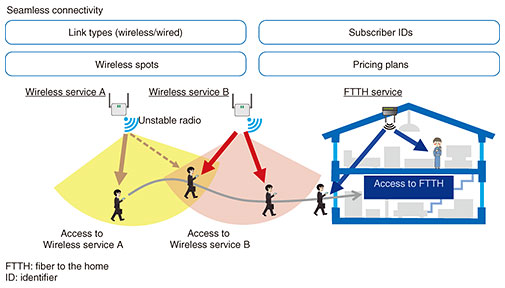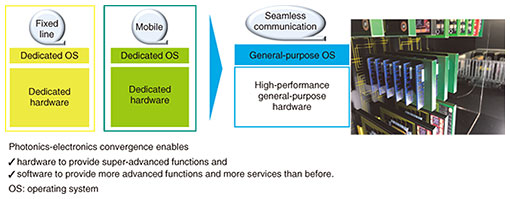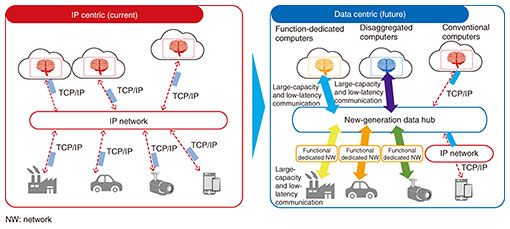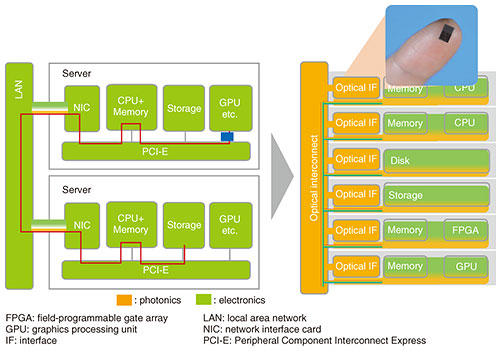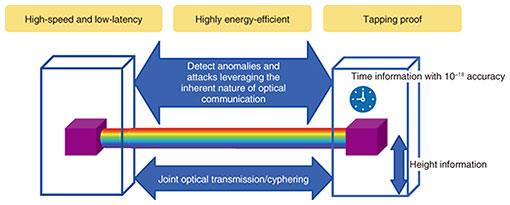 |
|||||
|
|
|||||
|
Feature Articles: Keynote Lectures at NTT R&D Forum 2020 Connect Vol. 19, No. 2, pp. 25–36, Feb. 2021. https://doi.org/10.53829/ntr202102fa2  Into the IOWNĄ˝Breakthrough InnovationsĄ˝AbstractThis article presents a lecture given by Dr. Katsuhiko Kawazoe, NTT Executive Vice President, Head of Research and Development Planning Department, at NTT R&D Forum 2020 Connect held from November 17th to 20th, 2020. The lecture introduced NTTĄÇs latest research and development activities, focusing on the Innovative Optical and Wireless Network (IOWN). Keywords: IOWN, photonic direct communication, Extreme NaaS, data-centric computing infrastructure, photonic disaggregated computing, secure optical transport, IOWN space computing 1. Humans are burdened by unknown risksI would like to start this speech on a bright and cheerful note, but unfortunately, this year I have to begin my talk with a serious topic. The emergence of the novel coronavirus has reminded us that humans are burdened by unknown risks. People are exposed to various risks even today in the 21st century. The report, “Global Challenges—Twelve Risks that Threatens Civilization” released in 2015 [1] lists risks such as global pandemics, extreme climate change, nuclear war, future bad global governance, and the impact of major asteroids. This is the number of asteroids that have been found to approach the Earth (Fig. 1). On average, about 30 new asteroids continue to be discovered every week. As you can see, there are still asteroids that haven’t been discovered with today’s observation technology. The asteroids shown in orange and red in the graph are dangerous because they are more than 140 meters long, capable of destroying cities. We need to further innovate and accelerate the discovery of dangerous asteroids.
Now what about the pandemic? Let’s look at the response to a pandemic from a computer simulation perspective. Supercomputers take years to simulate the characteristics and behavior of a new virus. We need to wait a year or more to come up with measures to respond to a new virus. If we could simulate a new virus in a dramatically short period and predict who is likely to become severely ill and what behaviors are likely to lead to the spread of infection, we would be able to rapidly come up with measures that are far more effective. To speed up such simulations, however, we have to break through the barriers of power consumption, density, latency, and heat problems that are creating limits to the performance of today’s computers. Our current technology is not yet sufficient to build a brighter future for humanity. 2. Digitalization for creating new valueSo what should we do? The introduction of digital signal processing has made information and communication technologies (ICT) faster, more versatile, and more efficient. It is fair to say that it has contributed to making our lives and economy richer. However, we recognized something by going through this pandemic. We are not facing just one problem. Multiple issues are intertwined, and there is no single value to address them. There are diverse ranges of value, and they will not remain the same. I believe digitalization, which will create new value that is necessary at that moment, is what we need going forward. Last year at the R&D Forum, I introduced the concept of “umwelt” (German term for “environment”) that German biologist Dr. Uexküll proposed. He said that organisms have their own information-recognition processes and the world (environment) is formed accordingly. The German philosopher Immanuel Kant’s “Copernican Revolution” served as the basis of Dr. Uexküll’s theory of the umwelt. Kant denied the idea that the world exists and humans recognize it, but insisted that the world is a phenomenon created by human cognitive forms, i.e., we all live in different umwelts. For example, we humans have a world in which we observe things such as beautiful flowers (Fig. 2(a)). In the world of insects and bees, the value is placed on flowers’ nectar on which to feed (Fig. 2(b)), and in the world of the reptilian snake, the value is placed on mice on which to feed (Fig. 2(c)). I hope you have experienced the unique umwelt of different species.
Let me give you one example of how digitalization has successfully created new value. The Japanese performing art kabuki is facing a major challenge of its fans getting older and failing to attract younger audiences. That’s why we tried to fuse the two umwelts of young and older generations who are passionate about kabuki. This is a collaboration between kabuki actor Nakamura Shido and the vocaloid* Hatsune Miku. Young people who were previously uninterested in kabuki are now watching it with great enthusiasm, sending in comments and shouting out at the performance, which is one of the traditions of kabuki viewing. Older kabuki fans also felt the benefits of a new style of stage production with Hatsune Miku and the state-of-the-art technology. We can probably say that a new value was created by fusing the two umwelts. I would say this embodies the essence of true digitalization we are aiming to achieve. The concept of the Innovative Optical and Wireless Network (IOWN) was announced in May 2019 to address unknown risks to humanity and to promote digitalization for the creation of new value. By introducing innovative optical technology into everything from networks to terminals and information processing, IOWN aims to solve the heat problem, which is putting limits on the performance of information-processing infrastructures, and to significantly improve the performance of power consumption, transmission capacity, and latency, compared to the current technology infrastructure, which is reaching its limits. This is truly a breakthrough innovation.
3. The progress in IOWNLet me now explain the progress in IOWN. At the last NTT R&D Forum, IOWN was described as having three major elements, the All-Photonics Network, Digital Twin Computing, and Cognitive Foundation®. The origin of IOWN is the development of the optical transistor with the world’s lowest energy consumption of 1.6 fJ/bit, announced in April 2019, and the development of optical devices has gone further. In November 2019, we announced the development of the world’s first all-optical switch with ultrahigh speed and low power consumption, and in March 2020, we fabricated the world’s first ultrahigh speed optical logic gate that can perform arbitrary logic operations using only optical interference, which will greatly expand the possibilities of optical technology (Fig. 3).
In light of these optical device advancements, this year I describe three common platforms that we will build on top of IOWN, which are “photonic direct communication,” “Extreme network as a service (NaaS),” and “data-centric computing infrastructure.” In addition, I would like to introduce various services created from these three common platforms (Fig. 4).
3.1 Common platforms(1) Photonic direct communication Photonic direct communication achieves a high-capacity photonic path with an optical interface. By connecting the system end to end with optical paths, low latency and high-capacity communication, high-precision time synchronization, multicasting to multiple locations, and natural information communication using advanced artificial intelligence (AI) would be possible. Also, one can build function-specific dedicated networks for each wavelength of light (Fig. 5).
The network configuration is an optical ring configuration, which allows for high reliability and rapid area deployment. Instead of having to add more cores as new demand arises, we can add branches as demand arises and cover a (large) area with minimum fiber optics. This means that it is possible to dynamically provide high-capacity optical paths capable of accommodating a diverse protocol stack. The addition of this optical branching is made possible by the special optical fiber polishing and branch connection technology. It allows for optical branching without interrupting the network. (2) Extreme NaaS The next common platform of IOWN is Extreme NaaS, a robust and flexible network services infrastructure. The innovative optical technology of IOWN and the multi-orchestrator of the Cognitive Foundation will allow for physical and functional integration of mobile and fixed networks, which means we can benefit from both mobile and fixed networks. In other words, it creates a new, robust, mobile/fixed seamless service that transcends network differences. Users are completely unaware of which network they are using and can continue to use the service stably even if their usage environment changes (Fig. 6).
In the demonstration experiment of the automatic operation of tractors in Iwamizawa City, Hokkaido, we implemented Extreme NaaS and achieved uninterrupted connection by anticipation prediction. Until now, handover among local fifth-generation mobile communication networks (5G), 5G, and broadband wireless access networks was not possible because networks are distinct from each other, but now they will stay connected even after a network has been switched. Since the tractors are monitored remotely via an ultralow latency network, they cannot continue to run if the network goes down. Because we are constantly monitoring the signal in the area that it is traveling, we can continue offering service by switching the network before it goes down. Mobile and fixed networks are, because of the difference in the services they offer, built on distinct network systems. This is because functional and performance levels are different, and each system is composed of dedicated hardware and software. Since the early 2000s, network devices have become increasingly open, as demonstrated by such cases as white box switches. Hardware and software are separated using general-purpose chips instead of custom chips. The use of general-purpose devices that can accommodate a variety of applications allows for a more economical system. Currently, general-purpose devices are also being deployed in 5G radio access networks. However, because this involves using general-purpose chips, its application has been limited because the performance of such chips is inferior compared with dedicated devices using custom chips. IOWN solves this problem by improving the performance of general-purpose chips using photonics-electronics convergence technology (Fig. 7). Photonics-electronics convergence makes the system usable in both mobile and fixed networks.
(3) Data-centric computing infrastructure The data-centric computing infrastructure is an ICT platform mainly composed of data or information and is an alternative to traditional Internet Protocol (IP)-centric computing (Fig. 8). In today’s networks, information is exchanged in IP packets and the Transmission Control Protocol (TCP)/IP protocols, regardless of the type of information involved. However, each type of information has its own characteristics and uses; therefore, optimal transmission and the processing method differ depending on the type of information. We propose a new computing architecture to develop a data-centric computing infrastructure.
In the current computing architecture, for large-scale information processing, each server unit is connected to a high-speed network to improve its computational processing power. However, latency becomes a major problem. In the photonic disaggregated computing that we are proposing, multiple memories and central processing units (CPUs) with optical input and output are directly connected by optical data transmission paths. To develop 800-Gbit/s-class photonics-electronics convergence devices to enable this ultrafast, high-capacity data processing, we prototyped a silicon photonics chip that performs ultrafast processing. This new computing architecture solves the heat problem and processing limitations caused by conventional power consumption and enables significant performance improvement in information-processing systems (Fig. 9).
3.2 Variety of services provided with IOWNNext, I will introduce a variety of services that can be provided with IOWN. (1) Well-being A future prediction service that would make our lives more fulfilling is highly expected. The point is to “visualize” and “simulate” one’s future changes, problems, and current physical condition. However, simulation of an individual’s “body” has not yet been achieved. Therefore, we are aiming to create a human digital twin, i.e., a bio-digital twin, by incorporating biological information through a digital twin device equipped with non-invasive blood and electrocardiographic sensing technology. We will conduct simulations and future predictions on such a digital twin to help determine individual symptoms during diagnosis and treatment phases, select the appropriate drugs, prevent disease, and even contribute to the discovery of the unknown self. To create a bio-digital twin, a digital twin device is needed that can accurately assess the body’s condition. One such device is the AI tele-stethoscope, which is currently under research and development (R&D). It is capable of collecting biological sounds from various parts of the body with an 18-channel wearable acoustic sensor and transmitting them to a remote location via a network with high sound quality. This tele-stethoscope is intended to support remote auscultation but will be developed as an AI stethoscope. The AI stethoscope will learn from various information to create three-dimensional (3D) models that will estimate the shape and movement of the heart to diagnose one’s heart from sound. (2) Zero environmental impact NTT has established a new lab, Space Environment and Energy Laboratories, to create innovative environmental energy technology in line with IOWN. This lab will contribute to achieving a sustainable and inclusive society and solving environmental problems from the space perspective. More specifically, we are working on artificial photosynthesis, lightening charge, and optimal operation control of nuclear fusion reactors. NTT was the first private company to sign a comprehensive cooperation agreement with the International Fusion Energy Organization (ITER). This project uses IOWN’s ultrahigh speed, ultralow latency network and Digital Twin Computing technology to achieve a complex and precise nuclear fusion reactor control system. We also signed a cooperation agreement with the National Institute for Quantum and Radiological Science and Technology (QST), which is aiming to achieve nuclear fusion in Japan. We are working together to create world-pioneering innovative energy technology. Dr. Kenichi Kurihara, Director General, Naka Fusion Institute, QST, sent us a message. (Message from Kenichi Kurihara Dr.Eng.) “NTT’s IOWN technology, which consists of very advanced optical and information processing technologies, will play a very important role in the nuclear fusion energy development project. We would also like to promote cooperation with NTT with a view to future implementation in power generation reactors. I hope that the fusion of research from different fields—NTT and the QST—will produce a new, first-of-its-kind technology that will make a significant contribution to the actualization of humanity’s dream of nuclear fusion energy.” (3) Lightning charge technology If abnormal weather leads to more lightning strikes, damage to people and facilities will become severe. We aim to accurately forecast locations of lightning strikes using Digital Twin Computing of IOWN in weather observation. Furthermore, research on harvesting lightning energy, for charging purposes, will press ahead. We are hoping to start lightning induction and charge experiments in the natural environment in 2022. (4) 4D digital platformTM The 4D digital platform is used to construct a digital twin in cyberspace on a real-time basis. This is made possible by using an advanced geospatial information database as the positional starting point, mapping real-world data with enhanced time accuracy, and collecting and integrating data at high speed. The 4D digital platform integrates 4D information, in other words, latitude, longitude, altitude, and time information in real time with precision. The digital twin constructed through such integration can make various future predictions and provide feedback to the real world. By leveraging the 4D digital platform and technologies associated with it, we will provide value in areas such as road-traffic rectification, urban-asset utilization, and collaborative maintenance of social infrastructure. We aspire to develop new sensing methods through optical-fiber environmental monitoring using optical technologies including IOWN and contribute to enhancing understanding towards the Earth in the areas of environment preservation and disaster reduction by using our optical lattice clock network technologies in the future. The 4D digital platform requires high precision/low cost object recognition technology. We applied the concept of umwelt that I introduced at the onset. What it means is that people recognize objects using visual information, whereas bats send out ultrasonic signals and use their reflected waves to perceive objects. Thus far, the NTT Group has used very high-performance and expensive LiDAR (light detection and ranging), which can capture positional relations to accurately grasp the position relation of electricity polls and other communication facilities. Therefore, we conducted experiments to see if we could combine visual information through the eyes and simple and inexpensive LiDAR to achieve better object-recognition performance than high-performance LiDAR, and the result as you see was very favorable. New value is created through the fusion of two umwelts or a compound environmental world (Fig. 10).
We will contribute to seaborne shipping through IOWN technology innovation. NTT and MTI Co., Ltd. signed an agreement on joint R&D for verification testing of the world’s first unmanned ship navigation system. We have a message from President Kazuo Ishizuka of MTI. (Message from Kazuo Ishizuka) “The biggest challenge for the NYK Group (including MTI) is to promote ESG (environmental, social, and governance) management together with our customers. What we envision for the future is to advance technological development with our industry partners on zero emission ships and autonomous ships. The common theme here is that logistics and vessels will be systematized more and more. High-speed high-capacity communication and high-precision positioning even on the ocean that IOWN aims to achieve is critical to us.” (5) Remote world In the post-COVID society, we must balance keeping social distance and vitalizing economic activities. This will be achieved through the remote world. NTT launched remote world as a service brand and started providing various services to achieve the new space beyond face to face. In R&D, we have advanced our immersive telepresence technology “Kirari!” that lets us believe as if a competition at a remote location were taking place right in front of our eyes and share the excitement of the venue. Amidst the coronavirus pandemic, various sports are being played without spectators, and our technology needs to evolve along with the change. For athletes, real-time cheers during the game gives them energy and encourages them. For spectators who are cheering for athletes, the sense of unity they feel with athletes and other spectators, through enthusiastic cheers, is the best part of the experience. To feel the sense of unity by encouraging athletes through passionate cheers, the most important thing is timeliness even when you are remotely viewing sports. This means that latency between the stadium and remotely participating spectators, and among spectators, has to be minimized to synchronize their emotions. This is very important. The latency issue can be addressed using photonic direct communication technology. This technology connects all the venues on a real-time basis, which lets us cheer athletes remotely and create a sense of unity among fellow spectators. We also believe that the sense of unity can be enhanced by installing sensors to detect the amount of heat in each venue and by devising means to control the brightness of the lighting depending on the strength of cheering. We have begun R&D on emotional perception technology that captures changes in spectators’ emotions and have them interplay with one another to generate a sense of unity or interaction. We are conducting joint research with Sony Corporation who has world-class expertise in device and interaction technologies. In the post-COVID society, in the era of remote world, thanks to ultralow latency technology, one will be connected without latency from a remote location and can feel as if he/she were in the same stadium. 3.3 IOWN Global ForumIOWN Global Forum, established in January 2020 by NTT, Intel, and Sony, has major global players who back technology innovation that IOWN aims to achieve such as Microsoft, Dell, Ericsson, and Nvidia. Membership is expanding day by day. We agreed on a plan to publish a technical core document as IOWN Global Forum Roadmap in 2021, decide specifications in 2024, and start IOWN compliant services by forum members in 2030. Having said that, NTT will not wait until 2030 but will announce new optical computing architecture in 2021. We will collaborate with various global partners for further innovation. 4. New challengesNow, let’s look at new challenges in expanding the field of R&D. 4.1 Globalization of NTT R&DTo expand and strengthen basic research further, we established NTT Research Inc. as an overseas basic research hub in April 2019, under which three labs started operation in July the same year and already produced great outcomes. For example, Cryptography & Information Security Laboratories had 12 papers accepted (15% of all accepted papers) by the top cryptography conference called CRYPTO. It is said that if you have 1 or 2 articles accepted a year, you are already a top class researcher in the cryptography field. As a part of global R&D, we started research activities on dementia care, a common social challenge in Japan and Australia. This is research to identify true needs of patients to give them the care they need. Researchers from various disciplines are coming together to have discussions on brain science and human interface to bring back the joy of life to patients through this research. This project is highly evaluated by the Australian Government. We’ve received messages from the honorary Simon Birmingham, Minister for Trade, Tourism and Investment as well as the honorary Dan Tehan, Minister for Education. (Message from Simon Birmingham) “NTT’s recent Comprehensive Partnership Agreement with Deakin University and Western Sydney University in Australia is the first of its kind outside Australia. This collaboration seeks to work together on issues of mutual interest to both our nations - across sustainable agriculture and food security, liveable cities, reliable renewal energy sources, and enhanced digital communications infrastructure. The first project is underway: to explore ways to harness technology to improve the quality of life for people living with dementia.” (Message from Dan Tehan) “The Australian Government is fully committed to encouraging stronger collaboration between our universities and businesses to create jobs, improve productivity, and open new business opportunities. Of course, the creation of a strong, new industry-led translational research capability, focused on positive socio-economic outcomes, is also a great gain for Australia. Working together, we can shape our future.” 4.2 SecurityThe next challenge is security. A cat and mouse chase with attackers has been continuing for a long time in security technology. In the IOWN era where everything is connected optically, we anticipate a new paradigm on security, including quantum key distribution, which is commanding attention. For example, by using an optical lattice clock, latency will be minimized to a time accuracy of 10–18, which allows us to make precise measurement down to centimeters. By using an optical lattice clock, authentication technology can be developed from a completely new perspective. We call this new authentication technology using an optical lattice clock “secure optical transport,” which is befitting (Fig. 11). Using the characteristics of light in the security field is indeed a challenge.
4.3 SpaceFinally, I’ll introduce our challenge in space. In November 2019, NTT and the Japan Aerospace Exploration Agency (JAXA) made an agreement to carry out joint research. We aim to achieve a seamless ground-to-space ultrahigh-speed large-capacity secure, optical and wireless communication infrastructure. In this joint research, multiple-input multiple-output technology will be applied to a satellite for the first time to solve the capacity problem that has been a bottleneck in satellite communications. We will solve this problem by expanding the capacity overwhelmingly and put in place low-cost Internet of Things (IoT) platforms in every corner of the world including areas without a terrestrial communication network. It has been decided to equip a communication satellite to be launched in fiscal year 2022 with this technology. We have a message from Dr. Masatoshi Harigae, Director General of Research and Development Directorate at JAXA. (Message from Masatoshi Harigae) “JAXA and NTT have signed a cooperation agreement to develop a large-capacity ultrahigh-speed and secure optical wireless communication infrastructure. Under this agreement, we have been conducting joint research so that outer space will be tapped into in the new information platform envisioned with IOWN.” One of our goals regarding this challenge is the IOWN space computing concept. Ultralow-energy-consumption computing capacity based on photonics-electronics convergence technology has unimaginable potential that goes beyond current technologies. We believe we can create a space datacenter that will process and analyze data on satellites. We have an eye toward a computing platform that processes and analyzes various observational data across satellites using energy only in outer space. Thanks to the various innovative technologies of IOWN that I introduced today, this will be a standalone ultra-stable permanent ICT infrastructure that will not have any impact on weather or further burden the Earth (Fig. 12).
5. Delivering breakthrough innovation for human happinessThus far, humans have come up with many innovations. Current technology lies on the accumulation of the past. We must act with a long-term vision as well as a short-term view. Happiness should not be considered momentary but temporally integrated so as to drive us to the best future possible through innovation. The infinite possibilities of technologies must be understood properly. This great challenge cannot be tackled with our knowledge alone. We must clearly face this issue with people from every sector to find a better way forward together. Today, I introduced the progress we’ve made and future challenges of IOWN. The NTT Group will contribute to all people through breakthrough innovations so that humans faced with unknown risks can remain happy. Thank you very much for your attention. Reference
|
|||||














